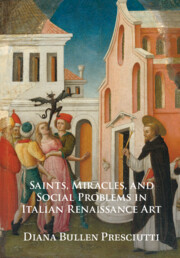Book contents
- Saints, Miracles, and Social Problems in Italian Renaissance Art
- Saints, Miracles, and Social Problems in Italian Renaissance Art
- Copyright page
- Contents
- Figures
- Acknowledgments
- One Introduction
- Two The Vita Icon Reimagined: New (and Old) Saints, New (and Old) Miracles
- Three Storytelling with Saints: Pictorial Narrative and Viewing Experience
- Four Girls in Trouble: Gendering Possession and Exorcism
- Five Assault, Amputation, Absolution: Visualizing the Power of Confession
- Six Thinking with Julian: Marital Violence and Elite Masculinity
- Seven Bernardino the Peacemaker: Visual Hagiography and Factional Violence
- Eight Cannibal Mothers: Picturing Madness and Maternal Infanticide
- Nine Making Innocence Visible (and Audible) in the Basilica del Santo
- Epilogue
- Bibliography
- Index
Four - Girls in Trouble: Gendering Possession and Exorcism
Published online by Cambridge University Press: 14 April 2023
- Saints, Miracles, and Social Problems in Italian Renaissance Art
- Saints, Miracles, and Social Problems in Italian Renaissance Art
- Copyright page
- Contents
- Figures
- Acknowledgments
- One Introduction
- Two The Vita Icon Reimagined: New (and Old) Saints, New (and Old) Miracles
- Three Storytelling with Saints: Pictorial Narrative and Viewing Experience
- Four Girls in Trouble: Gendering Possession and Exorcism
- Five Assault, Amputation, Absolution: Visualizing the Power of Confession
- Six Thinking with Julian: Marital Violence and Elite Masculinity
- Seven Bernardino the Peacemaker: Visual Hagiography and Factional Violence
- Eight Cannibal Mothers: Picturing Madness and Maternal Infanticide
- Nine Making Innocence Visible (and Audible) in the Basilica del Santo
- Epilogue
- Bibliography
- Index
Summary
In his life of St. Catherine of Siena, completed in 1395, Raymond of Capua relates the tale of the Dominican saint’s interactions with the Tolomei family of Siena.1 Raymond frames the story as one that reveals Catherine’s “singular gift of conversion” – in other words, her ability to reconcile wayward souls with God.2 The souls in question belonged to the eldest Tolomei son, Jacopo, and his sister Ghinoccia. Raymond tells of how Jacopo “lived very wickedly,” was “puffed up with pride,” and was “full of the poison of cruelty.”3 Although very young, he had already killed two men.4 For her part, Ghinoccia was vainly devoted to “adorning her body excessively.”5 Raymond goes on to describe how Catherine convinces Ghinoccia to reject her vanity, cut her hair (“which she took great pride in”), and embrace the Dominican habit.6 Jacopo proves to be more of a challenge, but Catherine is eventually able, with the help of Christ, to inspire him to “humble himself” and “confess his sins”; and subsequently, “a lamb was made from a wolf.”7 Jacopo, Raymond tells us, eventually married and lived peacefully, never again relapsing into his prior “bad habits.”8
- Type
- Chapter
- Information
- Saints, Miracles, and Social Problems in Italian Renaissance Art , pp. 116 - 152Publisher: Cambridge University PressPrint publication year: 2023

